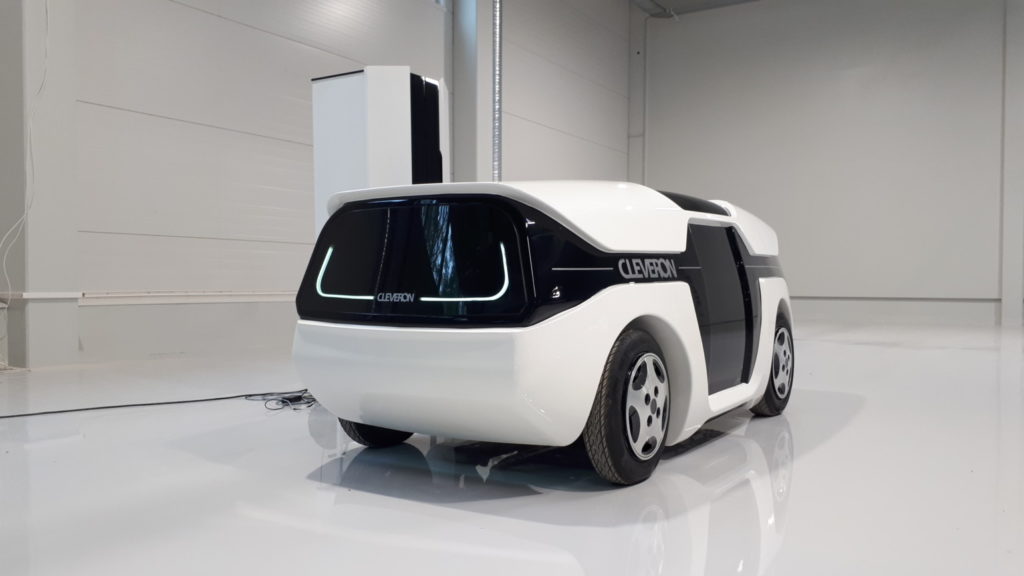Last week’s article about Cleveron’s new delivery robot stimulated much debate. Cleveron CEO Arno Kütt shares some exclusive insights into the robot’s workings and answers readers’ questions. With analysis from Marek Różycki (Last Mile Experts) and Ian Kerr (Postal Hub Podcast)
Last week we wrote about Cleveron’s new autonomous ground vehicle (AGV) that delivers to roadside parcel lockers, and considered how it compared to existing parcel delivery robots such as those from Starship Technologies. The article generated a lot of comment across social media, and we’ve been able to put some of readers’ questions to Cleveron CEO Arno Kütt.
Speed
Some readers questioned how fast the AGV would travel. Unlike Starship’s robot, the AGV travels on public highways and nobody wants to see delivery robots holding up traffic during peak times.
Cleveron says the robot won’t be slower than regular traffic – but will of course obey the speed limit. In addition these AGVs will operate during the night, when there is less traffic, so the risk of them causing congestion will be low.
Of course, we still see issues with the public’s fear of things that are new, in the same way as many consider air travel dangerous despite its enviable safety record versus road-based transport.
Safety
“The self-driving robot courier will be safer than a regular self-driving car with people in it,” Kütt told us.
“When a self-driving car transporting people is in a dangerous situation involving a pedestrian (for example, when a pedestrian steps into the road unexpectedly), the car must decide whether to protect the pedestrian or the passengers. With parcels there is no such dilemma – you always sacrifice the parcels. The self-driving car may drive off a cliff with the parcels, but the pedestrian will be safe.”
Cleveron believes that for this reason legislation for self-driving robot couriers will be resolved before that for self-driving cars.
This is a good point, as larger last mile autonomous vehicles designed to replace traditional delivery vans will be at a disadvantage until a ‘humanoid’ courier replacement is invented, as humans are still needed for doorstep deliveries.
Capacity
One reader commented that capacity would be an issue for Cleveron’s AGV. The capacity of the AGV in the video is less than that of a standard delivery van, perhaps comparable to a cargo trike.
But everybody needs to start somewhere, so we’re prepared to forgive a lack of capacity for the moment. Right now, the important thing is proving the concept. Cleveron’s learning curve with lockers started with standard lockers but has now evolved to include the eye-catching parcel tower, which is probably the pinnacle of APM technology today.
Cost savings
There are cheaper alternatives to residential delivery today, for example out-of-home delivery. But saving on price might be at the expense of the customer experience.
So, would there be any true savings from a delivery robot with such a modest capacity? If the vehicle becomes bigger and has a larger capacity, that would have significant implications for profitability.
The locker network
Cleveron is already testing personal ‘at home’ parcel lockers in Estonia. They can be rented in selected areas starting from €14.99 (US$) per month.
What is important here is that Cleveron has seen that the locker must be part of a carrier agnostic model.
“We have partnered with the national postal company, several logistics companies and supermarkets, who all deliver to the parcel locker. It holds regular mail, parcels and groceries,” says Kütt.
The parcel locker is operated by an app – the courier can access it with the app and the locker owner can control who has access to the locker via the app (from couriers to family members and friends).
“The start of the pilot has been successful and we have no doubt that in the future the parcel lockers will be a regular part of our lives. They are extremely convenient and save you time,” adds Kütt.
So it seems that the density of the locker network is dependent on residents renting locker space.
Capacity of the lockers is another question. Could the lockers be shared or serve multiple residences?
“In the current vision, the robot courier delivers to personal lockers in suburban areas. But in the future it can also deliver to a community parcel terminal such as our Cleveron 401, which is suitable for outdoor use. So use is not limited to personal parcel lockers,” explains Kütt.
Perhaps a further interesting variation would be to integrate these AGVs with PUDO points, allowing out-of-hours or off-peak parcel drop off. This would require a drop box or secure parcel locker to allow unattended delivery at the PUDO, but it would mean that parcels would be ready for customer collection from the moment the PUDO point opened in the morning.
Security
One UK reader commented, “In some parts of the UK they’d try to steal your wheels if you stop at a traffic light.” AGV manufacturers have tried to downplay this threat, but it is a risk nonetheless.
“The robot courier has security cameras to ensure safety and to register an offense if it happens,” says Kütt.
“But in reality, normally we order everyday items like T-shirts online. Stealing a T-shirt in a situation where you are easily identified is probably not worth the risk to anyone.”
We agree that stealing an individual item might seem a risk, but in some countries ‘porch pirates’ take that risk daily. If AGVs start carrying multiple consignments, then there’s an even greater incentive for miscreants to attempt to relieve robots of their shipments.
Then there’s still the issue of vandalism. The vehicle might go out in pristine condition but could return covered in graffiti.
Semi-autonomous competitor
In the past week Postmates has unveiled Serve, a semi-autonomous rover that uses cameras and lidar to navigate sidewalks. It will be monitored remotely.
Serve suffers the same restrictions as Starship’s offering, in that customers must unlock its cargo hatch with their phone or a passcode at the point of delivery.
So why is Postmates trialling this technology? Well, the long-term play might be to make delivery to the door a premium service. Would you be prepared to collect your order from a delivery robot in the street if it were cheaper?
Summary
Cleveron’s new AGV seems to be a step above Starship’s and even today’s airborne UAV drone delivery options. This will help set the delivery sector on a course toward unmanned deliveries. We might even see an ‘arms race’ between the major AGV manufacturers as they try to implement the ideal autonomous delivery model.
If you have any questions or comments on any of the articles featured in the Analysis section of Postal and Parcel Technology International, then please connect with the authors via LinkedIn or contact the editor at: Helen.norman@ukimediaevents.com




 Ian Kerr is the founder and host of the Postal Hub Podcast, the weekly podcast for the postal and delivery sectors.
Ian Kerr is the founder and host of the Postal Hub Podcast, the weekly podcast for the postal and delivery sectors.